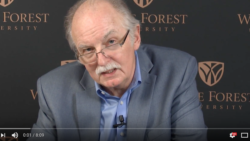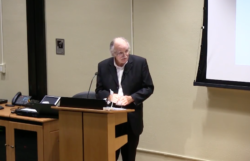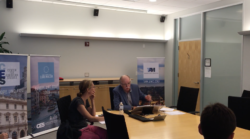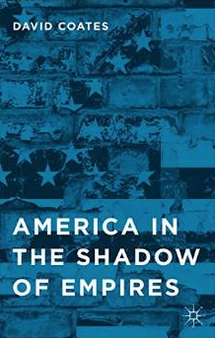Judging Presidential Candidates against our criteria rather than theirs (1) Poverty
If the events in Baltimore tell us anything general this week, it is surely that policies are more important than personalities, and that the solutions to our core problems require more than sound-bites.
Yet so far, the 2016 presidential campaign has been remarkably short on policies. To date, it remains a campaign full of sound-bites and dominated by personalities. If it is to culminate in real change in America, however, we need so much more.
We need as voters to draw up our own list of problems to be solved and solutions that will solve them. We need that list to be grounded in the best information available on each problem in turn, and to be as comprehensive as we can make it. And we need that list to be used to test the real potential of each candidate in turn, enabling us to judge them against our requirements rather than simply against their own.
If Baltimore is any guide,1 high on that list must be the issue of poverty.
I
The basic data on poverty is, of course, widely known and readily available.2 One American in seven is officially poor. One American in three is currently living in a family that is just one income-tranche away from the official poverty level for their size of family. One American child in five is living in poverty, with significantly greater levels of poverty among black and brown Americans and among particular social categories: ex-offenders, school drop-outs, welfare recipients including unmarried mothers, the disabled and the old. Any effective poverty program has, therefore, to cope both with extensive poverty and with poverty that is unevenly distributed regionally, socially, and generationally.
The uneven distribution suggests that poverty in contemporary America has more than one cause; and the extensiveness of the problem suggests that those causes will be deep-rooted and firmly entrenched. And they are: in truth more firmly entrenched for some Americans in poverty than for others, but difficult to shake off in every case. Poverty is a layered affair in contemporary America. There are rings of poverty, each inside the other. Some people are trapped inside all the rings, with multiple barriers blocking their access to decent incomes and a little wealth. Some are trapped by fewer barriers, with easier access. An effective set of anti-poverty policies, therefore, has to tackle the poverty-barriers in all their inter-connected complexity.
The most entrenched poverty in contemporary America is experienced by those wholly dependent on inadequate welfare payments: on temporary assistance for needy families, on supplementary nutrition (food stamps), on Medicaid and on housing vouchers. The individuals in that inner ring of poverty will be largely there through either their own mental/physical disability – their inability easily to participate in paid work – or through the lack of the skills necessary to survive on even low-paid work: the lack of support from another family member, the burden of raising children alone, and the lack of education skills linked to dropping out early from school.
But many other people in contemporary America are poor, and are poor in spite of being well-established in a stable family and possessing a full set of basic educational skills. They are poor – they will occupy the next ring – because (and in spite of their efforts at job hunting) of the lack of employment: poor because involuntarily unemployed, or poor because unable to move from part-time work to full-time work. Right now in the United States, there are at least 8.6 million Americans who want work and can’t get it (of whom 2.9 million have been unemployed for more than six months), 3a further 7 million with part-time work for want of something better,4 and probably 1.2 million who have dropped out of the labor market altogether, defeated in their pursuit of adequate employment of either a full-time or part-time nature.5
And yet others will be poor – or on the edge of poverty, rather than directly in poverty itself – because although they do have full-time work, their work is so badly paid that they are both full time workers and poor. According to the latest National Employment Law Project report, 42.6% of all US workers currently earn #15/hour or less.6 Do the math. Work a full 2000 hour year, and you gross just $30,000. If you have more than two children, that puts you on the edge of the official poverty line; and even if you have fewer or no children, it puts you firmly in the ranks of the one-in-three American workers surviving on an income that is within one tranche of the official poverty level for your size of family.7
The final ring – beyond these three – holds those many Americans with secure employment and adequate remuneration, the very goal of most people trapped in the inner rings. The distance to that optimal goal is clearly greatest for those on welfare, but still enormous and hard to cover for those who are involuntarily unemployed or working full-time for very low pay. The barriers to leaving the inner ring are particularly acute – there is a genuine “welfare trap” there – for as people move into paid employment (normally very poorly paid employment) their welfare benefits are pruned back, exposing them to an effective rate of taxation on their meagre earnings that can be very high indeed. The top 1% often complain about the disincentive effects of high taxation. They should try the move from welfare dependency to low-paid work if they really want to experience that disincentive effect at first hand.
II
Given the complexity of poverty and its causes in contemporary America, any adequate anti-poverty policy needs to combine a series of things.
It needs to help those fully dependent on welfare by improving the generosity of temporary welfare assistance, while simultaneously lowering the costs of moving from welfare to work. Those costs invariably involve transport and clothing costs, and – if children are involved – child care costs too.
An effective anti-poverty policy needs to phase out welfare benefits in an incremental fashion as people move from welfare to work – so lowering the effective rate of taxation on that income as people begin to earn it – and to target extra help to specific groups with particular barriers to work: not least the 800,000 ex-offenders released from US jails each year.
Additionally, an effective anti-poverty policy needs to make the move to work worthwhile, and to help those already in work but on low pay, by raising the minimum wage, extending earned income tax credits, improving child tax credits and allowing trade unions to form and to bargain.8
And it must also lower the level of unemployment, and bring good-paying jobs back to the United States in abundance, by targeted public spending to improve social and physical infrastructure, by industrial policy to draw private firms back into areas of high unemployment, and by the creation of barriers to the export of American jobs overseas. Politicians keen to reduce poverty certainly need to avoid signing trade deals that do exactly the opposite.
Republican austerity programs, that put the entire emphasis on cutting welfare and driving people off welfare-rolls, simply don’t suffice. At best, such policies moves the poor around on the low-income American chessboard – from poverty rooted in welfare dependence to poverty rooted in low wages – without addressing the development of skills, and the generation of more and more jobs that require high skills, which alone can guarantee over the long period the recreation of a high productivity, high-wage, globally-competitive US economy. Democratic policies that tinker with small-scale improvements (help with child care, for example) while giving the larger game away (not least by insisting on free trade with cheap labor competitor economies,) won’t suffice either. We should be looking for a candidate who will combine policies for a living wage with policies that manage trade and redistribute income and wealth more fairly.
Sadly, of course, if the first indicators of the nature of the 2016 campaign are any guide, we might be looking for such a candidate for quite some time. Maybe not, now that Bernie Sanders has entered the race. But either way, it will be worth the hunt to find one.
See also
Hammocks and Ladders: The Poverty of Republican Thinking on the Poor9
Responding to David Brooks: The Question of Poverty and Character10
1 http://www.alternet.org/economy/10-shocking-facts-about-baltimore?akid=13049.153278.qOGziq&rd=1&src=newsletter1035610&t=7
2 https://www.davidcoates.net/2015/02/27/hammocks-and-ladders-the-poverty-of-republican-thinking-on-the-poor/
5 David G. Blanchflower & Andrew T Levin, Labor Market Slack and Monetary Policy. NBER Working Paper 21094, April 2015: available at http://www.nber.org/papers/w21094
6 Irene Tung, Yannet Lathrop & Paul Sonn, The Growing Movement for $15, New York: National Employment Law Project, 2015, available at http://www.nelp.org/publication/growing-movement-15/
8 http://livingwagenyc.org/pagedetail.php?id=5 orhttp://americamagazine.org/issue/378/article/living-wage-movement
9 https://www.davidcoates.net/2015/02/27/hammocks-and-ladders-the-poverty-of-republican-thinking-on-the-poor/
10 https://www.davidcoates.net/2014/08/05/responding-to-david-brooks-the-question-of-poverty-and-character-2/
Tags: Baltimore, Food Stamps, Low Pay, poverty, poverty traps, presidential candidates, riots, unemployment, welfare dependency
David Coates holds the Worrell Chair in Anglo-American Studies at Wake Forest University. He is the author of Answering Back: Liberal Responses to Conservative Arguments, New York: Continuum Books, 2010.
He writes here in a personal capacity.





